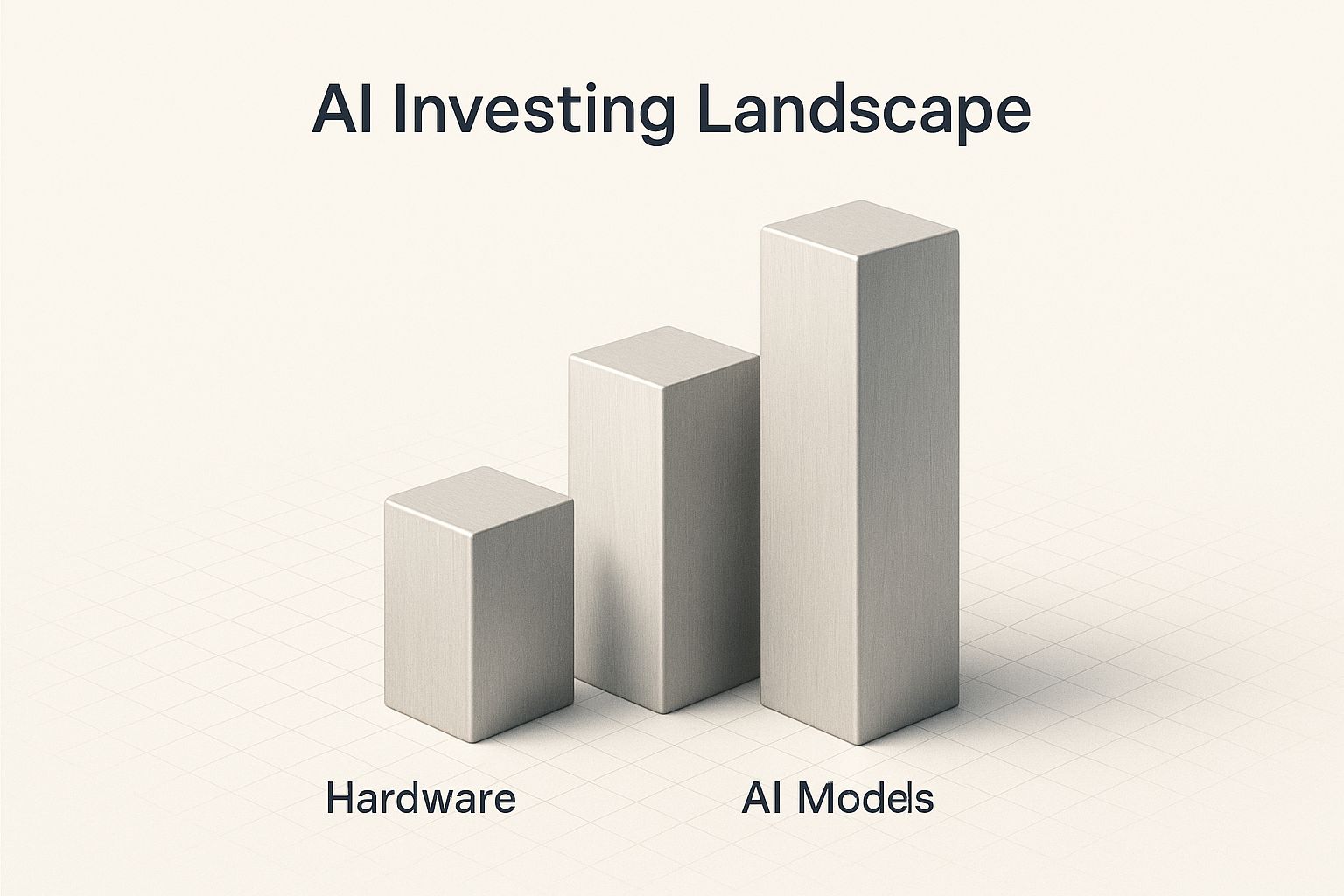Investing in AI stocks is more than just chasing the latest tech trend; it’s about strategically backing the companies fueling a significant economic transformation. From the semiconductor firms building essential hardware to the software developers engineering intelligent systems, understanding this ecosystem is key to making informed decisions.
Artificial intelligence isn't a single industry. It’s a foundational technology, much like electricity or the internet, that is actively reshaping the global economy. To succeed in investing in AI stocks, you must look beyond the hype and grasp the entire landscape.
Understanding The AI Investing Landscape
The artificial intelligence boom presents a compelling opportunity for investors, but successful participation requires more than simply buying shares in well-known tech giants. The term 'AI stock' is exceptionally broad, covering a diverse ecosystem of companies, each playing a distinct role in this technological revolution.
A useful analogy is the gold rush. You could have gambled on an individual miner, hoping they struck gold. Alternatively, you could have invested in the businesses selling picks, shovels, and supplies—the essential tools every miner needed.
The AI world functions similarly, and it’s helpful to break it down into three core pillars.
The Three Pillars of AI Investment
To build a robust investment strategy, you must differentiate between the various layers of the AI market. Each pillar offers unique opportunities and risks, allowing you to tailor your approach to your financial goals and risk tolerance.
- Hardware (The 'Picks and Shovels'): This is the bedrock of the AI industry. It includes companies that design and manufacture high-performance hardware, such as semiconductors and GPUs, that make artificial intelligence possible. These components are critical for everything from massive data centers to the AI features in your smartphone.
- AI Models (The 'Masterminds'): These are the firms developing the large language models (LLMs) and core algorithms driving innovation. They are the brains of the operation, creating the sophisticated systems that other businesses leverage to build their products.
- Integrators (The 'Application Builders'): This group consists of businesses that integrate AI into their existing products and services to create new value. Examples include software-as-a-service (SaaS) companies, cloud providers, and firms in sectors like healthcare or finance that use AI to enhance efficiency.
This infographic helps visualize how these three pillars interact, with hardware forming the foundation for AI models, which in turn empower application builders.

This visual clarifies that the AI market is a layered ecosystem. Each tier is dependent on the one below it, and each offers a distinct entry point for those interested in investing in AI stocks.
The Scale of the Opportunity
The economic impact of this technological shift is projected to be immense. The global AI market is estimated to reach $371.7 billion in 2025 and is forecasted to grow to an incredible $2.4 trillion by 2032.
This extraordinary growth trajectory is fueled by deep investment, particularly in North America. The US private sector alone saw AI investments of $109.1 billion, significantly outpacing other nations. To get a better sense of where this capital is flowing, it's worth exploring trends in venture capital AI investing.
This rapid expansion is precisely why a clear investment framework is crucial. For those looking to delve deeper, our guide on investing in robotics and AI offers further perspective on this closely related field. By understanding these market dynamics, you can better position yourself to capitalize on what is shaping up to be a long-term, transformative trend.
How to Spot Promising AI Companies

When evaluating AI stocks, traditional methods of picking winners are insufficient. While strong financials are always essential, the true indicators of a promising AI company are often found in areas that don't appear neatly on a balance sheet.
Identifying a future leader requires looking beyond current revenue and focusing on the drivers of a long-term competitive advantage in the world of artificial intelligence.
Think of it this way: anyone can purchase the best paintbrushes, but it takes a true artist with a unique vision to create a masterpiece. Similarly, many companies can license AI tools, but only a select few possess the internal DNA to build a sustainable edge. This requires shifting your due diligence toward the qualitative factors that signal genuine, defensible innovation.
The goal isn't just to find companies using AI. It's to find the ones fundamentally built to win with AI.
Looking Beyond the Financials
You can discern a lot about a company's commitment to AI by where it allocates its resources for the future, not just by its current profits. The most critical non-financial clues point to a deep, strategic dedication to leading the field.
These are the areas that demand your attention:
- Research & Development (R&D) Spending: A consistent and significant investment in R&D is non-negotiable. It signals that a company is serious about pushing boundaries rather than just relying on yesterday's technology. Don't just look at the absolute number; analyze the R&D budget as a percentage of revenue and compare it to its peers.
- Talent Acquisition: The competition for top AI talent—from data scientists to machine learning engineers—is incredibly fierce. A company's ability to attract and retain these experts is a powerful leading indicator of its technical prowess. Look for companies led by respected figures in the AI community.
- Strategic Partnerships: No company succeeds in isolation. Pay close attention to partnerships with top universities, innovative startups, and other key industry players. These collaborations often serve as a pipeline to cutting-edge research and new markets.
While these metrics may not be found in a simple financial report, they reveal a great deal about a company's foundation. A comprehensive guide on how to analyze financial statements will provide the quantitative baseline, but the story of an AI leader is written in its people and its vision.
The Power of a Data Moat
If one competitive advantage matters more than any other in the AI era, it is the data moat. This refers to a company's unique, proprietary dataset that is massive, valuable, and nearly impossible for competitors to replicate. High-quality, exclusive data is the fuel that trains the most powerful and accurate AI models.
A company without a strong data moat is building its AI house on rented land. True, defensible value comes from owning a unique data asset that continuously improves its AI models, creating a virtuous cycle that competitors cannot easily break.
Consider a major e-commerce platform. Every search, click, and purchase generates a unique data point. This enormous, proprietary dataset allows it to train recommendation algorithms that are far more effective than anything a new competitor with no user history could build. That is a classic data moat in action.
Assessing the AI Strategy and Monetization
A brilliant AI model is merely a science project without a clear path to monetization. A truly promising AI company must have a coherent strategy for converting its technological strength into real-world revenue.
You need to ask these critical questions:
- Is the AI core to the business? Is AI a central pillar of the company's value proposition, or is it just a feature added for marketing buzz?
- What is the monetization model? How does the company generate revenue from its AI? Is it through subscriptions, usage-based fees, significant efficiency gains, or the creation of entirely new products?
- Is the technology scalable? Can the AI solution be deployed widely and cost-effectively, or is it a custom-built system that is too difficult to replicate for a broader market?
Ultimately, spotting a promising AI company involves a blend of traditional financial analysis and a forward-looking assessment of its technological foundation, data advantage, and business strategy. This is the only way to navigate the complexities of investing in AI stocks and identify businesses truly positioned for lasting success.
Analyzing the Real Risks of AI Investing
It’s easy to get caught up in the incredible potential of AI stocks, but the path to returns is filled with significant risks that extend beyond typical market fluctuations. A clear-eyed assessment of these challenges is essential for any serious investor looking to navigate this space.
The promise of world-changing technology often overshadows the practical hurdles. These are not just theoretical concerns; they directly impact a company's valuation, profitability, and even its long-term survival. Understanding them is the first step toward building a resilient portfolio.
The High Cost of Innovation
The engine of AI is constant innovation, and that engine is incredibly expensive to operate. The sheer cost of remaining at the forefront creates enormous financial pressure, even for the largest players.
- Intense R&D Investments: Leading AI companies must invest billions in research and development just to stay competitive. For instance, Microsoft is projected to invest a staggering $80 billion in a single fiscal year to build out its AI data centers. This level of spending is a massive barrier to entry and a constant drain on cash.
- The Talent War: The competition for world-class AI experts is ruthless. Companies must offer extraordinary compensation packages to attract and retain top talent, which directly impacts their operating margins.
- Sky-High Computing Expenses: Training advanced AI models requires an immense amount of computational power. The cost of acquiring and running high-performance GPUs and other specialized hardware can be prohibitively expensive, squeezing profitability.
These relentless costs mean that many promising AI ventures may exhaust their capital long before achieving sustainable profitability.
Navigating Regulatory and Ethical Minefields
The AI industry is operating in a regulatory gray area, where today’s breakthrough can easily become tomorrow’s liability. This uncertainty introduces a layer of risk that is difficult to quantify but impossible to ignore. A single new regulation could reshape the entire competitive landscape overnight.
Furthermore, the ethical dimension of AI is becoming a major business concern. Public perception regarding issues like data privacy, algorithmic bias, and job displacement can significantly impact a company’s brand and bottom line.
A company’s failure to address ethical AI concerns is no longer just a PR problem; it is a direct threat to its market access and consumer trust. Investors must evaluate how proactively companies are managing these risks, as they can quickly turn into serious financial headwinds.
A company perceived as irresponsible may face consumer boycotts, employee walkouts, and intense regulatory scrutiny, all of which can seriously damage shareholder value.
Mitigating AI Investment Risks
While these risks are formidable, they are not a reason to avoid the sector entirely. A strategic approach can help manage the potential downsides and position your portfolio for long-term success. The key is to avoid concentrating your capital in a single company or a narrow segment of the AI market.
A disciplined investment strategy should include:
- Diversification Across Sectors: Spread your investments among the different pillars of the AI ecosystem. Hold positions in hardware manufacturers, model developers, and established companies integrating AI into their businesses. This approach helps insulate your portfolio from a downturn affecting any one area.
- Adopting a Long-Term Horizon: The AI revolution will unfold over decades, not quarters. Avoid making reactive decisions based on short-term market noise. Instead, focus on companies with durable competitive advantages, such as a strong data moat or a clear path to monetization.
- Focusing on Established Leaders: It's wise to balance more speculative, high-growth plays with investments in stable, well-capitalized companies. These giants have the resources to weather economic downturns and fund the sustained R&D required to lead.
By acknowledging the high costs, regulatory hurdles, and ethical challenges, you can move beyond the hype. This enables you to build a more durable and thoughtfully allocated portfolio prepared for the inevitable disruptions of technological change.
Building a Diversified AI Stock Portfolio

Successfully investing in AI stocks isn't about placing a single large bet on a company you hope will become the next giant. It's about constructing a thoughtful, balanced portfolio that aligns with your financial goals and personal risk comfort.
The key is to create a mix of assets that captures the broad potential of the AI revolution while protecting you from the volatility associated with any single stock. This approach transforms investing from a speculative gamble into a disciplined strategy.
Think of it less like picking individual stocks and more like an architect designing a resilient structure. A well-constructed AI portfolio should be able to withstand market shocks while positioning you for long-term growth.
The Core-Satellite Strategy for AI Investing
A proven method for achieving this balance is the core-satellite approach. This strategy involves dedicating the majority of your portfolio to stable, well-established companies (the "core") and allocating smaller portions to higher-growth, more speculative opportunities (the "satellites").
Your core holdings act as the foundation, providing stability and steady returns. These are typically large-cap, blue-chip companies with strong balance sheets and a demonstrated ability to effectively integrate AI.
The satellite portion is where you can take more calculated risks. These allocations might include smaller, pure-play AI startups or companies in emerging sectors poised for rapid expansion. This structure allows you to pursue significant upside without jeopardizing your entire portfolio's stability.
Broadening Your Exposure with AI ETFs
For investors who want broad exposure without the intensive research required for individual stock selection, AI-focused Exchange-Traded Funds (ETFs) are an excellent tool. These funds hold a basket of companies from various corners of the artificial intelligence ecosystem.
By investing in an AI ETF, you gain instant diversification across dozens or even hundreds of companies. This approach smooths out the impact of any single company’s poor performance and provides a simpler way to bet on the growth of the entire sector.
Several ETFs focus on different themes, such as robotics, cloud computing, or general AI technology. Choosing the right one allows you to align your investment with the specific sub-sectors you find most promising. Learning the fundamentals of how to diversify a portfolio is a crucial first step before allocating capital to specialized funds.
Tailoring Your Portfolio to Your Risk Tolerance
Your personal risk tolerance should be the ultimate guide in structuring your AI stock allocation. A portfolio suitable for a young investor with a long time horizon will look very different from one designed for someone nearing retirement.
Here’s how you might apply the core-satellite model based on different risk profiles:
- Conservative Portfolio: 70-80% in core holdings (like established tech giants and AI-focused ETFs) with 20-30% in lower-volatility satellite positions.
- Moderate Portfolio: A more balanced 60/40 split between core and satellite investments, allowing for a healthy mix of stability and growth potential.
- Aggressive Portfolio: A 50/50 or even 40/60 allocation, with a greater emphasis on high-growth, pure-play AI companies that carry higher risk but also offer greater reward potential.
The growth of the AI market has been remarkable, often outpacing broader market indexes. For example, the specialized AI-INDEX saw an 86.2% performance gain in 2020, more than doubling the Nasdaq Composite's 42.4% growth. This trend continued into 2023, with the AI-INDEX rising 77.6% compared to the Nasdaq's 46.3%, highlighting the sector's powerful momentum. By carefully structuring your portfolio, you can position yourself to participate in this growth while effectively managing your risk exposure.
Learning from the AI Market Leaders
Theory is valuable, but seeing how it applies in the real world is essential. The best way to understand what makes a winning AI investment is to study the companies currently dominating the field.
By analyzing these market leaders, we can move past abstract concepts and see what successful strategy and execution look like. We’ll examine a few distinct examples: a company manufacturing essential chips, another providing the cloud backbone, and a third embedding AI directly into its software.
Each offers a powerful lesson in building a durable competitive advantage. Their success stories demonstrate the importance of deep R&D, powerful data moats, and a clear path to monetization.
Case Study: The Chip Manufacturer
At the foundation of the AI boom are the semiconductor companies designing the high-performance chips—specifically, graphics processing units (GPUs)—that modern AI models require. One key player has built a near-monopoly not just by producing the best hardware, but by creating an entire software ecosystem (like CUDA) that developers are now dependent on.
This dual advantage creates an incredibly sticky platform. Developers build their applications on this specific architecture, making it extremely difficult for a competitor to gain traction, even with comparable hardware. It’s a masterclass in the power of building an entire ecosystem, not just a single product.
Case Study: The Cloud Infrastructure Provider
One layer up are the major cloud providers who rent out the massive computing power needed to train and deploy AI. These giants have expertly leveraged their existing global network of data centers to offer "AI-as-a-service," making sophisticated technology accessible to businesses of all sizes.
Their competitive edge is built on sheer scale, reliability, and the seamless integration of a vast library of AI tools and models directly into their cloud platforms. This strategy cleverly transforms AI from a massive upfront capital expense into a manageable operating cost for their customers. In doing so, they've positioned themselves as the essential utility providers for the entire AI economy.
The market has certainly taken notice. Investment trends show just how valuable these foundational players are. For instance, the Morningstar Global Next Generation Artificial Intelligence Index posted a 29.33% return as of September, significantly outperforming the broader market's 11.75%. You can discover more about the performance of leading AI companies and see how top-rated firms like Amazon and Alphabet are capitalizing on these trends.
Common Questions About AI Stock Investing
Navigating the world of AI investing can raise many questions, especially with the market moving so rapidly. Let's address some of the most common ones to help you build the confidence needed to make sound, strategic decisions for your portfolio.
Below are clear, straightforward answers designed to reinforce the key ideas from this guide and provide actionable advice.
Is It Too Late to Invest in AI Stocks?
Not at all. While some well-known names have seen impressive gains, the AI revolution is still in its early stages. Think of it like the internet in the late 1990s—the true, long-term impact is just beginning to materialize.
There are still massive opportunities across all three pillars of the ecosystem. You can find incredible potential in companies building foundational hardware, those developing advanced models, and the countless businesses integrating AI to transform entire industries like finance and healthcare. The key is to focus on companies with solid, long-term fundamentals rather than chasing short-term hype.
How Can I Invest in AI Without Picking Individual Stocks?
For investors who want broad exposure without the risk tied to single-stock picking, AI-focused Exchange-Traded Funds (ETFs) are an excellent solution. Funds like ROBO, BOTZ, or AIQ hold a diversified basket of companies from across the AI, robotics, and automation sectors.
This approach provides instant diversification by spreading your investment across dozens of companies. It effectively reduces the impact if any single company in the fund performs poorly, offering a much simpler way to bet on the overall growth of the sector.
What Is the Most Important Factor When Analyzing an AI Stock?
While many factors are critical, a company's 'data moat' is often the most significant long-term advantage. This refers to a company's unique, proprietary data that is incredibly difficult for competitors to replicate or acquire.
High-quality, exclusive data is the essential fuel needed to train the most effective and accurate AI models. This creates a powerful and sustainable competitive advantage that gets stronger over time as more data is collected.
When evaluating a potential investment, always ask how the company gathers, protects, and leverages its data to create value. A strong data moat is one of the clearest signs of a business built to last in the AI era. For those new to the field, mastering the fundamental investment decision-making process is crucial before diving into AI stocks.
At Commons Capital, we specialize in helping high-net-worth individuals and families navigate complex financial landscapes. Our team provides expert guidance to help you build a portfolio that aligns with your long-term goals. To learn how we can help you achieve your financial objectives, visit us at https://www.commonsllc.com.






